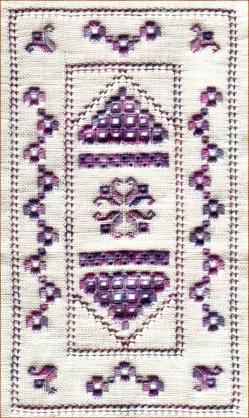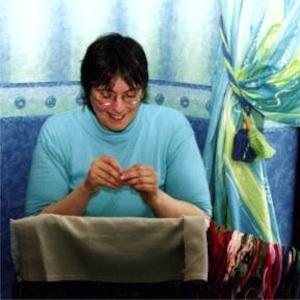- Home
- What do I need?
- Embroidery Fabric
Choosing embroidery fabric
for counted thread projects
As a beginner to counted thread work the sheer number of suitable embroidery fabrics available totally confused me.
I loved the traditional look of linen but the lady in the craft shop recommended Aida instead.
I was tempted to skip the beginner fabric as to my eyes it looked ugly but when she went on to explain that learning the technique without worrying about potential tension issues could save me money and frustration I accepted her wisdom.
That advice saved me from the frustration I later saw other stitchers experience - including one of my own early attempts on linen that ended up as a parallelogram instead of a rectangle!
📌 In this guide, you'll learn:
✔ The differences between Aida, Evenweave, and Linen
✔ How fabric count affects your stitches
✔ The best fabric for your skill level and project type
✔ Which needle sizes to use for different fabrics
✔ Tips for transitioning from Aida to finer fabrics
✔ How to stitch on non-evenweave fabric using Waste Canvas
Understanding Fabric Count and Sizing
🎥 Prefer video? Watch this quick Embroidery Fabric Count Explained tutorial to see fabric differences in action!
You can follow along by clicking the transcript button, below.
Before selecting a fabric, you need to understand fabric count—the number of threads per inch. This directly affects how large or small your finished stitches will appear.
When you buy a pattern it will usually tell you which fabric size the designer used, but you don't have to stick to this. However, if you change to a different count you will need to work out how that will affect the amount of fabric you'll need.
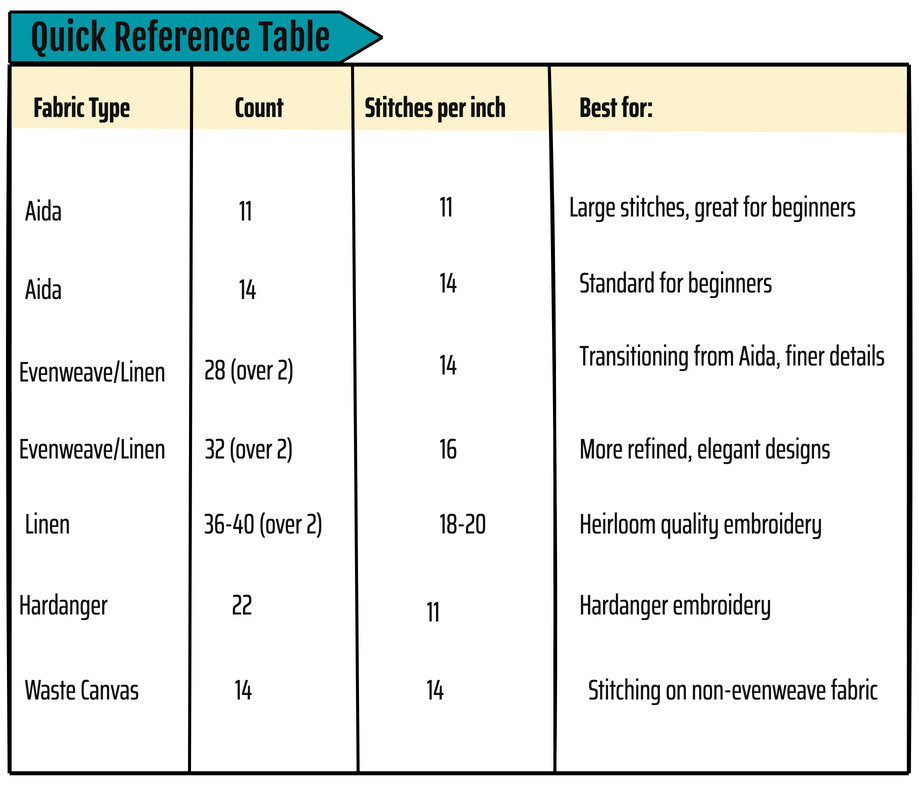
✅ Try This! Use our Cross-Stitch Size Calculator to instantly determine the ideal fabric count for your project.
Calculating the Amount of Fabric to Buy
If you are going to frame your finished stitching you will need to consider any unstitched area around the design. If you do not leave enough, the end result can seem cramped and squashed into the frame. A larger design will often look better with more empty space.
Let's look at an example: If you have a design size of 5" x 7" and you want a clear 2 inch mounting margin (1 inch on each side), plus another 3 inch framing allowance then you would want to cut the fabric to 10" x 12".
Also keep in mind that evenweave and linen can fray around the edges.
You have various options for edge protection:
✔ Machine stitch around the outside (this is what I recommend).
✔ Apply fray check solution.
✔ Tape the edges.
I find the last one requires extra fabric and I can't bear the sticky residue that often remains and would want to cut this off once the work is completed. I also find it make the edges stiff and uncomfortable to hold while stitching, but that might just be me.
Which Needle Size Should You Use?
Choosing the right needle size is crucial for achieving smooth stitches, preventing fabric damage, and ensuring a comfortable stitching experience.
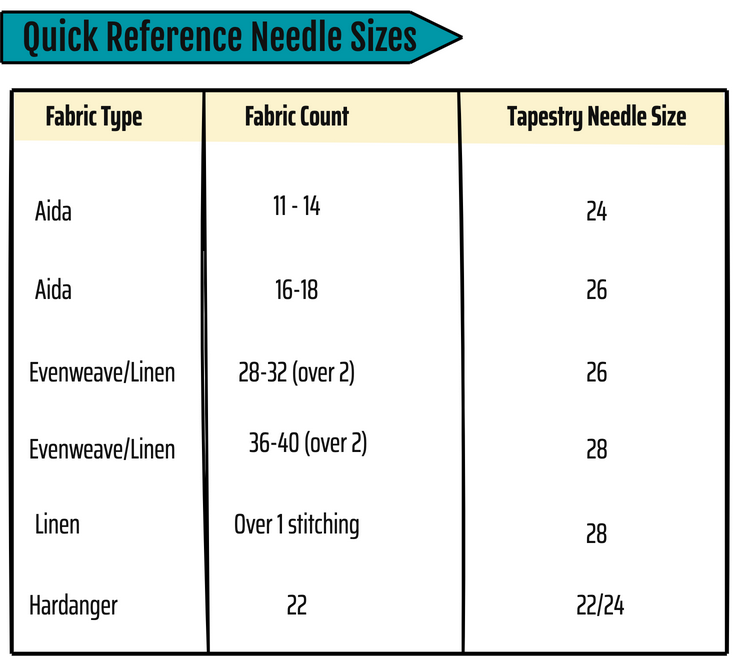
📌 Needle Selection Tips:
✔ Tapestry needles have a blunt tip—perfect for counted thread embroidery because they slip easily between fabric threads without splitting them.
✔ Higher needle numbers = finer needles (e.g., Size 28 is finer than Size 24).
✔ For fractional stitches on Aida, use a sharp embroidery needle to pierce the fabric more easily.
✔ If stitching on dark fabric, consider using a gold-plated or titanium needle—they reflect light better, making them easier to see.
🔗 Related Guide: Not sure which embroidery needles to use? Read this in-depth guide!
Starting With Aida Fabric
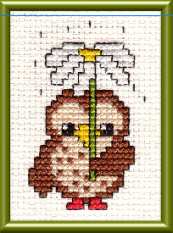
When I first started counted thread embroidery, I was tempted to skip Aida fabric because I preferred the look of linen.
However, Aida's firm, block-weave structure makes it the perfect learning fabric. Its stiff texture holds its shape well, even without a hoop, and the clearly defined holes make counting simple and accurate.
🧵 Your questions answered
Understanding Aida
Most beginners start with 14 count Aida (14 holes per inch) and use 2 (or sometimes 3) strands of embroidery floss for cross stitch. This gives a good coverage
The firmness of the weave will mean it is easy to keep the right tension.
The tapestry needle will help you to go through the holes and not pierce the bunched together fabric threads.
However, at some point you may decide you want to use fractional cross stitches to add a smoother shape to your blocks of colour. As it can be tricky to pierce the exact centre of the solid blocks to create quarter and three quarter stitches this is the point when you might feel it's time to move to evenweave fabrics.
🔗 Related Guide: Learn more about fractional stitches in our full guide.
📌 Quick Summary:
✔ Beginner-friendly—easy to see and stitch
✔ Holds its shape well—can be stitched without a hoop
✔ Widely available in many colours and counts
❌ Less ideal for detailed work—limited finer counts
❌ Blocky appearance—visible squares may not suit all designs
❌ Not ideal for working fractional stitches
🛒 Looking for Aida in different colors? Check out Aida fabric options here.
Moving to Evenweave Fabric
When I first switched from Aida to evenweave, I was delighted by its more refined appearance.
While it still offers the consistent spacing that helps with accurate counting, it creates a much smoother background for your stitching. I found it to be the perfect stepping stone before tackling pure linen.
I typically work with 25 (Lugana) or 28 (Jobelan) holes per inch evenweaves.
I found it required a new counting technique, as it involves stitching over 2 fabric threads, meaning I had to retrain my eye!
However, I picked this up quite quickly and soon realised that 28 divided by 2 = 14, meaning the end result was the same size as the Aida I had been using previously.
My biggest adjustment was the lack of big holes and learning to bring the needle up between the fabric threads without piercing them. Regular checking helps ensure my stitches aren't going over one or three threads instead of two
Evenweaves tend to be softer to handle than the stiff Aida and come in a range of colours. I always use a hoop to keep the fabric threads straight and taut.
🧵 But What If?
Jobelan 28 count
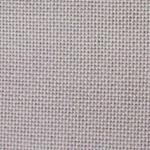
Jobelan is made from 51% cotton and 49% modal. It comes in either a 28 or 32 thread count evenweave, with a slight sheen that is ideal for stitching table linens or cushions (pillows). Being a cotton blend, it hangs well and is easy to wash.
Annabelle 28 count
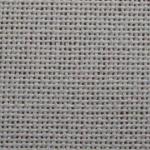
Lugana is an evenly woven cotton blend fabric composed of 52% cotton and 48% viscose.
It comes in different thread counts, normally worked over two fabric threads.
📌 Quick Summary:
✔ Smooth texture—no blocky grid
✔ Allows fractional stitches—ideal for fine details
✔ More detailed designs—supports higher thread counts
❌ Counting takes focus—stitching over two threads is trickier
❌ Softer fabric—works best with a hoop or frame
Graduating to Linen Fabric
Linen is often considered the gold standard for counted thread embroidery, and with good reason.
I love how its organic appearance, with its slightly uneven threads and natural slubs, creates a beautiful background for stitching. However, these same characteristics that make it appealing can also make it challenging to work with.
📌 Quick Summary:
✔ Elegant, traditional appearance
✔ Fine stitch detail—supports very high thread counts
✔ Perfect for specialty techniques—great for Hardanger, drawn-thread work
❌ Uneven thread thickness—requires careful counting
❌ Less forgiving—misplaced stitches are more noticeable
❌ More expensive—higher cost than Aida or evenweave
If my budget permits, I find pure linen is the best fabric to embroider on. Linen is a durable, single thread hand embroidery fabric woven from 100% flax.
Because of the fibre, fabrics made from linen can have bumps or "slubs" which make them more tricky to work on. Also loosely woven linens mean that any embroidery floss carried across the back of the work is visible from the front. This loose weave also means linen requires careful tension control.
Linen embroidery fabrics come in a variety of thread counts and mostly natural colour choices.
Some well-known linens are:
- Glenshee - 19 count
- Dublin - 25 count
- Cashel linen - 28 count
- Belfast linen - 32 count
- Edinburgh - 36 count
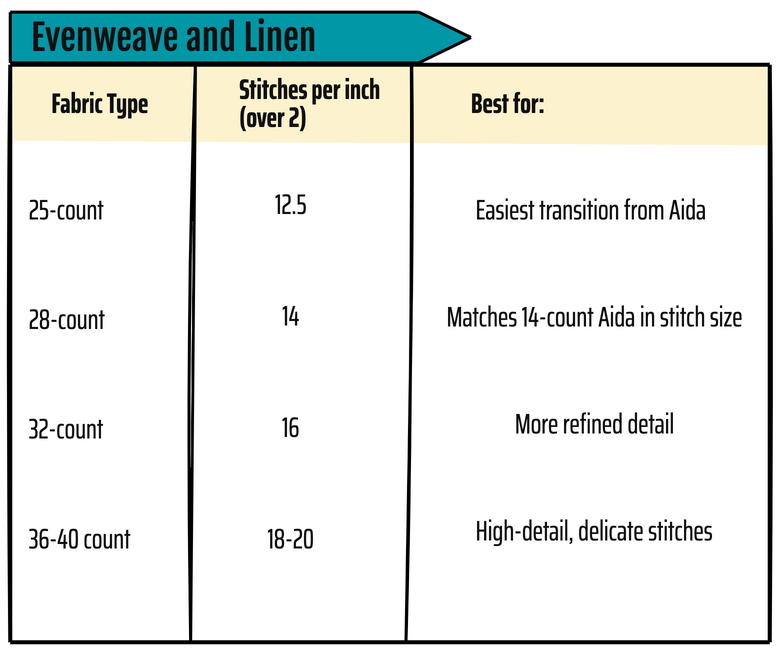
🔗 Related Guide: "New to evenweave? Learn how to stitch on evenweave & linen.
Hardanger Fabric: The Specialty Weave
Hardanger fabric (also called Oslo) is a 22-count even-weave cotton where threads lay in pairs instead of a single grid.
It is commonly used for Hardanger embroidery, a Norwegian technique involving cutwork, open spaces, and decorative stitches.
📌 Best For: Hardanger embroidery, drawn-thread work, openwork techniques
📌 Not Ideal For: Cross-stitchers who need a clear block weave like Aida
📌 Quick Summary:
✔ Unique block-weave structure—great for cutwork embroidery
✔ Pairs of threads make designs more intricate
✔ Holds shape well—easy to stitch without a hoop
❌ Not as soft as linen or evenweave
❌ Cutwork requires precision and experience
🔗 Related Guide: New to Hardanger embroidery? Learn how to stitch Hardanger techniques.
Waste Canvas: Stitch on Any Fabric!
What is waste canvas?
Waste Canvas is a temporary, removable embroidery fabric that allows you to stitch a counted thread design onto any non-evenweave fabric, such as clothing, tote bags, or home décor fabrics.
It has a similar grid structure to Aida but is made from a stiffer, water-soluble or pull-thread material that can be removed after stitching.
📌 Best For: Stitching on garments, tote bags, denim, felt, and other non-evenweave fabrics
📌 Not Ideal For: Traditional cross-stitch projects where the fabric is the background
📌 Quick Summary:
✔ Allows cross-stitch on any fabric (jeans, shirts, pillowcases, etc.)
✔ Temporary grid system makes stitching easier
✔ Available in multiple counts (most commonly 14-count)
❌ Requires extra finishing steps (removal process)
❌ Stiff material can be difficult to work with
🔗 Related Guide: New to Waste Canvas? Follow this step-by-step tutorial!
Your Fabric Journey
When I look back at my early counted thread pieces, I can see how each fabric type taught me something valuable.
Aida gave me confidence in my basic technique, evenweave helped me develop precision in counting and placement, and linen taught me to work with, not against, the natural characteristics of the fabric.
Don't rush to move from one fabric to the next. Each stage builds skills that will serve you well as you progress. Remember, it's not about achieving perfection - it's about creating beautiful pieces you can be proud of, regardless of which fabric you choose.
Still confused about embroidery fabric?
This is the place to ask your questions about what fabric to use? How to take care of it? How to stitch on it, etc.
Can you help answer other people's questions?
Click below to see what other visitors to this page have asked...
Aida to evenweave 




Hi
If I buy a kit that has aida fabric in & want to replace with evenweave, how do I work out how much fabric to buy?
Is it like for like?
Many thanks …
Number of Counts 




I wish to know how to consider the count number of a Canvas? For example is a 14 Count canvas bigger (bigger holes) than an 18 Count?
Thank you very …
Needlework and techniques 




Can you do embroidery and cross stitch on the same type of fabric? If so, which fabric is best if you want to incorporate cross stitch with some embroidery …
Choosing the right embroidery fabric 




Why does a design say to stitch it on a #14 f(or 16 or 11, etc.) fabric?
Can't I stitch on any fabric I like? Like, on a garment that I want to decorate …
Cross stitch fabric too stiff 




Is it OK to wash the fabric to soften it before starting a cross stitch project? It is very hard to get the Hoop on and work with it.
Best fabric for a mix of cross stitch and embroidery 




I have been cross stitching on Aida for a while now and I am keen to try out some other fabric types.
I have some of my own designs (I create custom …
Particles on evenweave when unpicking stitches 




Question: I recently bought evenweave fabric for the first time and tried cross-stitch on it. However, as I progressed on the stitches, I found that …
Switching from aida for the first time to linen/evenweave! 




I have seen the difference in the result of a picture when it is worked on linen/evenweave as opposed to Aida. I have replaced my 14 count Aida with 28 …
Fabric for beads 




Question: I am wondering what fabric to use for beading. It would be embroidery with beads, its a pretty big project. I am looking for fabric that won't …
Fabric/thread conversion 




Question: Help please. I have a project and the pattern call for 32 ct linen using two strands of floss over two threads. I am going to stitch this project …
How to stitch on Dublin Linen 




I am an experienced cross stitcher, however, I have never stitched on linen fabric. I recently purchased a beautiful pattern that requires that I use …
I have holes or tears in my fabric. 




Question: I have been stitching for years, have always used 14 count or maybe 11 count.
Lately I have had a tear or hole in my fabric after weeks …
Stitching over 2 on 32 count Belfast linen 




What Does it mean to Stitch 2 over 2 on Belfast Linen 32 Ct?
How do I remove creases in aida cloth 




Question: I have purchased many pre-packed cross stitch kits and the aida cloth always has pressed creases it it. I wondered how I can remove them …
Using a different count evenweave fabric? Not rated yet
hi, I have been following your fantastic Hardanger tutorials and I achieved really good results, thanks to your very clear instructions. It's definitely …
stitching on linen Not rated yet
I just purchased a pattern that is calling for stitch on 32 count (I don't know what that means) Misty blue linen.
I could not find this, so I purchased …
Stay connected between projects
If you’d like occasional updates from my embroidery room, including new patterns, gentle tips, and little things I think you might enjoy, you’re warmly invited to join the Stitchin’ Times newsletter.
No pressure. Just a friendly note now and then to keep you inspired.
